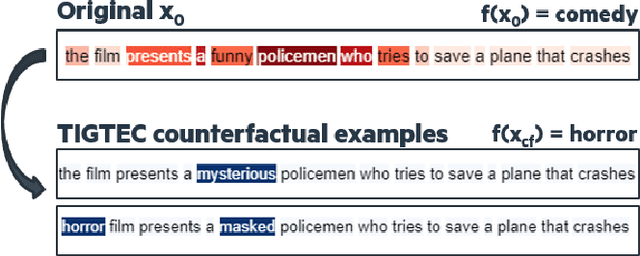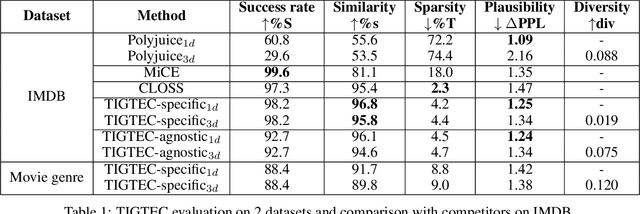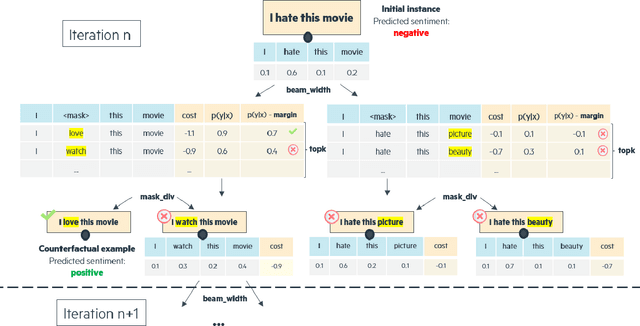Nicolas Chesneau
Did I Faithfully Say What I Thought? Bridging the Gap Between Neural Activity and Self-Explanations in Large Language Models
Jun 12, 2025Abstract:Large Language Models (LLM) have demonstrated the capability of generating free text self Natural Language Explanation (self-NLE) to justify their answers. Despite their logical appearance, self-NLE do not necessarily reflect the LLM actual decision-making process, making such explanations unfaithful. While existing methods for measuring self-NLE faithfulness mostly rely on behavioral tests or computational block identification, none of them examines the neural activity underlying the model's reasoning. This work introduces a novel flexible framework for quantitatively measuring the faithfulness of LLM-generated self-NLE by directly comparing the latter with interpretations of the model's internal hidden states. The proposed framework is versatile and provides deep insights into self-NLE faithfulness by establishing a direct connection between self-NLE and model reasoning. This approach advances the understanding of self-NLE faithfulness and provides building blocks for generating more faithful self-NLE.
Magazine Supply Optimization: a Case-study
Aug 16, 2024Abstract:Supply optimization is a complex and challenging task in the magazine retail industry because of the fixed inventory assumption, irregular sales patterns, and varying product and point-of-sale characteristics. We introduce AthenIA, an industrialized magazine supply optimization solution that plans the supply for over 20,000 points of sale in France. We modularize the supply planning process into a four-step pipeline: demand sensing, optimization, business rules, and operating. The core of the solution is a novel group conformalized quantile regression method that integrates domain expert insights, coupled with a supply optimization technique that balances the costs of out-of-stock against the costs of over-supply. AthenIA has proven to be a valuable tool for magazine publishers, particularly in the context of evolving economic and ecological challenges.
Mitigating Text Toxicity with Counterfactual Generation
May 16, 2024



Abstract:Toxicity mitigation consists in rephrasing text in order to remove offensive or harmful meaning. Neural natural language processing (NLP) models have been widely used to target and mitigate textual toxicity. However, existing methods fail to detoxify text while preserving the initial non-toxic meaning at the same time. In this work, we propose to apply counterfactual generation methods from the eXplainable AI (XAI) field to target and mitigate textual toxicity. In particular, we perform text detoxification by applying local feature importance and counterfactual generation methods to a toxicity classifier distinguishing between toxic and non-toxic texts. We carry out text detoxification through counterfactual generation on three datasets and compare our approach to three competitors. Automatic and human evaluations show that recently developed NLP counterfactual generators can mitigate toxicity accurately while better preserving the meaning of the initial text as compared to classical detoxification methods. Finally, we take a step back from using automated detoxification tools, and discuss how to manage the polysemous nature of toxicity and the risk of malicious use of detoxification tools. This work is the first to bridge the gap between counterfactual generation and text detoxification and paves the way towards more practical application of XAI methods.
Learning Structural Causal Models through Deep Generative Models: Methods, Guarantees, and Challenges
May 08, 2024



Abstract:This paper provides a comprehensive review of deep structural causal models (DSCMs), particularly focusing on their ability to answer counterfactual queries using observational data within known causal structures. It delves into the characteristics of DSCMs by analyzing the hypotheses, guarantees, and applications inherent to the underlying deep learning components and structural causal models, fostering a finer understanding of their capabilities and limitations in addressing different counterfactual queries. Furthermore, it highlights the challenges and open questions in the field of deep structural causal modeling. It sets the stages for researchers to identify future work directions and for practitioners to get an overview in order to find out the most appropriate methods for their needs.
ClimateQ&A: Bridging the gap between climate scientists and the general public
Mar 18, 2024Abstract:This research paper investigates public views on climate change and biodiversity loss by analyzing questions asked to the ClimateQ&A platform. ClimateQ&A is a conversational agent that uses LLMs to respond to queries based on over 14,000 pages of scientific literature from the IPCC and IPBES reports. Launched online in March 2023, the tool has gathered over 30,000 questions, mainly from a French audience. Its chatbot interface allows for the free formulation of questions related to nature*. While its main goal is to make nature science more accessible, it also allows for the collection and analysis of questions and their themes. Unlike traditional surveys involving closed questions, this novel method offers a fresh perspective on individual interrogations about nature. Running NLP clustering algorithms on a sample of 3,425 questions, we find that a significant 25.8% inquire about how climate change and biodiversity loss will affect them personally (e.g., where they live or vacation, their consumption habits) and the specific impacts of their actions on nature (e.g., transportation or food choices). This suggests that traditional methods of surveying may not identify all existing knowledge gaps, and that relying solely on IPCC and IPBES reports may not address all individual inquiries about climate and biodiversity, potentially affecting public understanding and action on these issues. *we use 'nature' as an umbrella term for 'climate change' and 'biodiversity loss'
Self-AMPLIFY: Improving Small Language Models with Self Post Hoc Explanations
Feb 19, 2024Abstract:Incorporating natural language rationales in the prompt and In-Context Learning (ICL) has led to a significant improvement of Large Language Models (LLMs) performance. However, rationales currently require human-annotation or the use of auxiliary proxy models to target promising samples or generate high-quality rationales. In this work, we propose Self-AMPLIFY to generate automatically rationales from post hoc explanation methods applied to Small Language Models (SLMs) to improve their own performance. Self-AMPLIFY is a 3-step method that targets samples, generates rationales and builds a final prompt to leverage ICL. Self-AMPLIFY performance is evaluated on two SLMs and two datasets requiring reasoning abilities: these experiments show that Self-AMPLIFY achieves good results against competitors. Self-AMPLIFY is the first method to apply post hoc explanation methods to SLM to generate rationales to improve their own performance in a fully automated manner.
TIGTEC : Token Importance Guided TExt Counterfactuals
Apr 24, 2023



Abstract:Counterfactual examples explain a prediction by highlighting changes of instance that flip the outcome of a classifier. This paper proposes TIGTEC, an efficient and modular method for generating sparse, plausible and diverse counterfactual explanations for textual data. TIGTEC is a text editing heuristic that targets and modifies words with high contribution using local feature importance. A new attention-based local feature importance is proposed. Counterfactual candidates are generated and assessed with a cost function integrating semantic distance, while the solution space is efficiently explored in a beam search fashion. The conducted experiments show the relevance of TIGTEC in terms of success rate, sparsity, diversity and plausibility. This method can be used in both model-specific or model-agnostic way, which makes it very convenient for generating counterfactual explanations.
Evaluating self-attention interpretability through human-grounded experimental protocol
Mar 27, 2023Abstract:Attention mechanisms have played a crucial role in the development of complex architectures such as Transformers in natural language processing. However, Transformers remain hard to interpret and are considered as black-boxes. This paper aims to assess how attention coefficients from Transformers can help in providing interpretability. A new attention-based interpretability method called CLaSsification-Attention (CLS-A) is proposed. CLS-A computes an interpretability score for each word based on the attention coefficient distribution related to the part specific to the classification task within the Transformer architecture. A human-grounded experiment is conducted to evaluate and compare CLS-A to other interpretability methods. The experimental protocol relies on the capacity of an interpretability method to provide explanation in line with human reasoning. Experiment design includes measuring reaction times and correct response rates by human subjects. CLS-A performs comparably to usual interpretability methods regarding average participant reaction time and accuracy. The lower computational cost of CLS-A compared to other interpretability methods and its availability by design within the classifier make it particularly interesting. Data analysis also highlights the link between the probability score of a classifier prediction and adequate explanations. Finally, our work confirms the relevancy of the use of CLS-A and shows to which extent self-attention contains rich information to explain Transformer classifiers.
Detecting Parts for Action Localization
Jul 21, 2017



Abstract:In this paper, we propose a new framework for action localization that tracks people in videos and extracts full-body human tubes, i.e., spatio-temporal regions localizing actions, even in the case of occlusions or truncations. This is achieved by training a novel human part detector that scores visible parts while regressing full-body bounding boxes. The core of our method is a convolutional neural network which learns part proposals specific to certain body parts. These are then combined to detect people robustly in each frame. Our tracking algorithm connects the image detections temporally to extract full-body human tubes. We apply our new tube extraction method on the problem of human action localization, on the popular JHMDB dataset, and a very recent challenging dataset DALY (Daily Action Localization in YouTube), showing state-of-the-art results.
 Add to Chrome
Add to Chrome Add to Firefox
Add to Firefox Add to Edge
Add to Edge